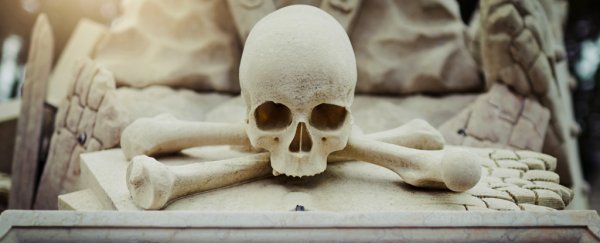When your old Aunt Petunia passes away, there's a good chance her body will either be reduced to ash inside a purpose-built kiln or buried in an expensive (but not too expensive) wooden box next to the decaying remains of Uncle Harold.
If only she'd lived in another time, or another place, things could have been very different.
Different cultures have disposed of human remains in wide variety of ways, some a little more colourful than others.
And we might need to revisit some of them soon, because, let's face it, we can't keep packing our dead into prime real estate.
In this 5-minute TED-Ed video, historian and author Keith Eggener digs deep into the past of funerary practices to explore how today's cemeteries evolved, and imagines where they'll be in the future.

The history of the human funeral is a tough topic to study. Other animals typically have little to do with the remains of their loved ones, and if we go back far enough, our ancestors were no different.
So at some point in history we went from stepping around dead bodies to purposefully disposing of them. Identifying when this change took place is a bit of a challenge.
Several hundred thousand year old hominin bones found in a pit in Spain's Atapuerca Mountains were once hypothesised to be the oldest evidence of a mortuary ritual, on account of being found among tools nobody in their right mind would throw down a hole.
Recent research has cast doubt on that thought, suggesting the much more gruesome explanation of cannibalism and leaving the question of just when our rituals first evolved up for debate.
Neanderthals were almost certainly interring the remains of the dead with respect tens of thousands of years ago.
The charred remains of an Australian Aboriginal woman near Lake Mungo represent the oldest cremation, at around 40,000 years old. So we've been disposing of the dead for at least as long as that.
Even if we can't settle on an exact 'when', we're left with the question of 'why?'
Mortuary practices were well underway long before writing was a thing, so we can only speculate their reasons.
Eggener suggests the first burials might have been less than reverent, with those low on the social ladder being thrown into a pit while those higher up were given a fancy send-off.
At some point it's possible that some viewed burial as a more appealing option, preferring it to being dried or eaten in plain sight.
Whatever the inspiration was, burials were relatively common by the time the first settlements appeared around 10,000 years ago. Cultures far and wide began to store their dead in shared locations, such as underground catacombs or suburban necropolises.
In fact, we get the word 'cemetery' from ancient Greek words meaning sleeping chamber.
Today we see these kinds of landscapes as sombre spots for quiet contemplation. Yet this whole 'rest in peace' attitude has also varied throughout the centuries.
Eggener describes the medieval cemetery as a place where markets and fairs were often held, and farmers would graze their livestock (apparently grass grown over graves made for sweeter milk – try using that in your advertising these days!).
Our historical appreciation of the cemetery as a community centre began to lose its appeal by the end of the 19th century, coinciding with the rise in popularity of public parks and botanical gardens, says Eggener.
But even today there a range of funeral alternatives still in practice.
Various forms of so-called sky burial can still be found in remote parts of Tibet and Mongolia, for example, where bodies are deliberately left to the elements and scavengers to consume.
There are also plenty of examples of mummification still happening around the world, where bodies are preserved in some manner before being housed with dignity.
Expanding populations in city centres and value in recycling and reusing resources might soon see an end to the traditional cemetery, forcing us to rethink our attitudes towards the dead.
Knowing what the future of death will look like is almost as speculative as understanding our past. Eggener has a few suggestions which are well worth considering.
Maybe Aunt Petunia should be turned into a tattoo. It's not like she wanted to spend eternity next to Uncle Harold anyway.
ScienceAlert staff writer Mike McRae writes more on death and disease in his new book, Unwell: What makes a disease a disease?
Available online and in all good Australian bookstores.
